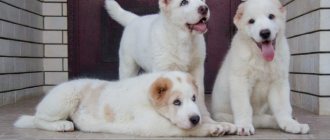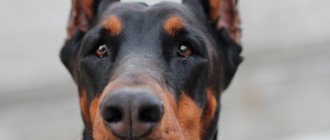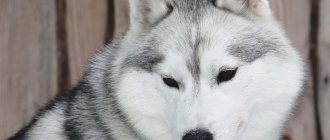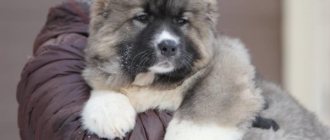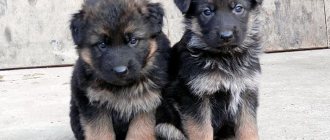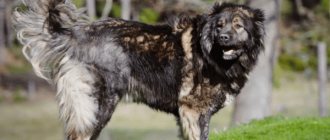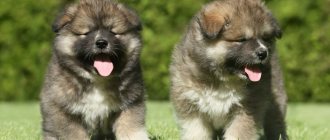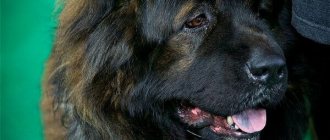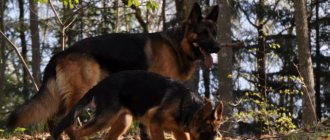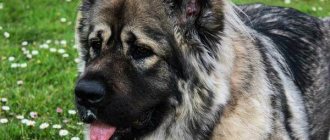The Caucasian Shepherd is classified as a large type of dog - it is distinguished by its large size, strength and endurance. She has a strong bone structure, well-developed muscles and a rough type of body structure. This breed was bred to serve people in harsh mountain conditions - therefore its representatives tolerate harsh climate and difficult living conditions well.
However, in order for a Caucasian Shepherd puppy to grow up healthy and strong according to all criteria, you should take care of the correct diet and diet. Before you get such a pet, you need to study as fully as possible how to feed a Caucasian Shepherd puppy. At the same time, it is important to know the average statistical data on how much a Caucasian Shepherd puppy weighs by month - this will be needed in order to periodically check how well your pupil is growing.
Preliminary information
The exterior of Caucasians begins to form immediately after birth - this process lasts a whole year and ends at approximately 12 months. From 1 to 7 months the most rapid development occurs, so at this stage it is especially important to organize the correct regime and feeding of the Caucasian Shepherd. A well-designed menu implies the presence of all the necessary nutrients, an optimal balance of carbohydrates, proteins and fats, as well as the quality and variety of food.
In any case, when taking your baby from the breeder, ask what he was fed there - first you will have to adhere to the same scheme and the same diet. You cannot suddenly switch your puppy to a different diet - this can cause severe stress in the body. Only after a month can you begin to gradually change the regime and menu - this will give the baby the opportunity to endure the changes without unnecessary worries and worries.
Diet from the third month
From three months, the shepherd dog can be fed 4 times a day, increasing the amount of food by 1 meal. Meat should be given approximately 350 grams daily. Boiled sea fish is gradually introduced into the diet. Buckwheat, rice, and oatmeal are suitable for preparing porridge. The serving size is set individually. The offered food should be eaten by the dog within 15 minutes.
From 4 months, the number of feedings of the Caucasian Shepherd is reduced and is increased to 3 times a day by 8 months of age. You can give your dog boiled offal. The daily meat intake increases to 450 grams. Vegetables can be seasoned with sour cream, and cottage cheese can be added to porridge. If you are intolerant to milk, you must replace it with fermented milk products.
Vitamins and mineral supplements
When eating natural foods
A good addition to the daily menu would be:
- bone flour;
- fish fat;
- live yeast;
- powdered eggshells.
A couple of times a year, it is advisable to give your dog complex industrial supplements:
- Farmavit Active;
- 8 in 1 Excel;
- Unitabs;
- WolmarW
It is recommended to do a blood test first to understand exactly what substances your pet is lacking.
How to feed a Caucasian Shepherd
The amount of food and number of feedings should correspond to the age of the dog. Puppies aged 8 to 12 weeks need to be fed 4 times a day, from 3 to 6 months - 3 times a day, from 6 months to 1 year - 2 times a day. For dogs older than one year, it is enough to feed them once a day, but some dog breeders divide the daily amount of food into two times.
It is important not to overfeed dogs, especially during puppyhood. Caucasian Shepherds mature slowly, up to 3-5 years. Therefore, a rapid jump in the development of muscles and skeleton leads to health problems, in particular with the musculoskeletal system. It is important that during the period of growth and maturation of puppies, products contain a small percentage of fat and protein.
The amount of food depends on the size and activity level of the dog, and the composition of the food. With natural feeding, 35-45 grams of food per 1 kg of animal weight is enough, for example, a dog weighing 45 kg needs about 1.5 kg of food per day. As for dry food, you need to focus on the values indicated on the packaging in the line of food allowance for large and giant breeds. Sometimes it is necessary to increase the norm by 15-20%. Usually 15 grams per 1 kg of animal weight is enough.
It should be remembered that in the summer, pets, especially on hot days, may lack appetite. This phenomenon is normal, so there is no point in worrying and trying to force feed your dog, especially by offering harmful treats. In winter, the calorie content of food must be increased if the animal lives outside.
Sources of essential substances
A pet can receive the substances necessary for growth and development by feeding it both on a natural diet and on ready-made industrial feeds. If you have any doubts about what to feed a Caucasian, you need to consider the following. Caucasian Shepherds are not prone to allergies and have a stable digestive system, so it is better to choose natural products. This feeding method is more economical, but more time-consuming and requires a certain ratio of basic substances in the diet.
Squirrels
Protein food is the basis for the formation of a healthy body and has a beneficial effect on the development of powerful muscles. The main products containing protein are:
- meat and meat products;
- dairy products;
- eggs;
- fish.
Meat is a natural and favorite food for dogs.
Little Caucasians should be offered raw beef, boiled rabbit or chicken. It is better to distribute the daily amount of meat over several feedings. Instead of meat, you can give offal 2-3 times a week. It is allowed to add blood from slaughtered animals to the diet. Within a few hours after slaughter, blood can be used in its raw form (except pork). Blood contains beneficial amino acids, has an antimicrobial effect, and prevents iron deficiency anemia. Fish should be given no more than 2 times a week. Each portion of fish should be larger than the meat portion, which corresponds to the age of the dog. The puppy can be fed raw or boiled sea fish. River fish must be boiled. Before feeding, make sure there are no bones.
The yolk of a raw egg is usually mixed in milk. Sometimes you can give boiled protein or an egg in the form of an omelet.
Possible problems
The reasons why a pet eats poorly can be divided into two groups:
- psychological;
- physiological.
The first group includes the anxious or nervous state of the animal. Perhaps you are away from home too often and your dog is getting bored. Or the calm and measured life of a pet was disrupted by a sudden move or arrival of people unfamiliar to him. A dog may not eat well even during heat.
The second group includes such things as indigestion, scratches in the mouth, for example, from bone fragments, and the presence of parasites (worms). An animal does not eat well when it is sick. For example, the cause may be malfunction of the thyroid gland, complications of cardiac activity, kidney or lung disease, or cancer.
Also, the Caucasian Shepherd may begin to eat poorly if it has experienced severe shock or is in pain. In hot weather, your dog's appetite may also decrease.
If you notice that your dog is not eating well, be sure to take action. First of all, watch her. Perhaps the animal simply ate something from the ground and will have an appetite for its next meal. Try not feeding your pet for 24 hours so that he gets hungry. Access to clean water is a must.
If after a day the Caucasian Shepherd’s appetite has not returned, and she herself looks lethargic, immediately show the dog to the doctor. Most likely she got sick.
Adult dog diet
The basis of the diet, as a natural predator, is meat and offal. Raw horse meat and beef are optimal. The dog should receive at least 600 grams of meat per day. The diet may contain offal, which is less nutritious than meat, but contains more useful elements, in particular unpeeled tripe, which is given raw. The heart, liver, kidneys and lungs must be thoroughly boiled to avoid infection with worms. It is acceptable to sometimes give raw beef bones. Mixed with other products, meat and bone meal should be given in the amount of 100 grams per day.
Upbringing
Until the age of three months, a Caucasian Shepherd puppy is taught only the basic nuances of obedience and behavior in the house, but the age from three to nine months is already excellent for the formation and development of a dog through targeted training.
Now your pet’s psyche is most susceptible to external stimuli, because the breed lacks the genetically inherent adaptive abilities to live in big cities or simply in noisy places. However, at the same time, with a competent approach to learning, new information will be perceived much easier than at an older age.
It should be noted right away that raising a Caucasian wolfhound is not a task for weak-willed people, because if the dog feels the slightest uncertainty or weakness of its owner, then nothing good will come of it. Also, if possible, it is very advisable to enlist the support of an experienced dog handler, who will prompt and guide you at the right time, helping you to avoid a serious mistake in raising a puppy of such a formidable breed.
With the help of a specialist, your pet will quickly complete the general training course, with the main commands that you should pay special attention to: “fu”, “near”, “place”, “come to me”, “lie down” and “sit”.
In addition, it is equally important to train your pet to give back a taken object when ordered, and experts recommend introducing fetching into a puppy’s training program from a very early age.
How exactly to raise a Caucasian Shepherd puppy is up to each owner to decide for himself, but do not forget that you do not have a Pekingese and in an unforeseen situation the animal may behave rashly or even aggressively, the responsibility for which will fall entirely on your shoulders.
Representatives of this breed are distinguished by considerable intelligence, so with the right approach and long-term training, you can raise a real devoted protector from a cute fluffy ball. The more time you spend with your pet, the better you will learn about his character, temperament and intelligence, which will only help in further building your relationship.
Important! Training both at home and on the playground should be carried out by the same person.
To summarize, we must admit: the Caucasian Shepherd is an ideal dog only for strong-willed people who are truly interested in its adequate upbringing. If you are not confident in your abilities or simply don’t have time to take care of a pet, then this option is not for you, and don’t let the puppy’s cute appearance confuse you.
Caring for a Caucasian Shepherd includes choosing the right diet. When a puppy appears in the house from a mother dog, you need to ask the breeders what they fed the dog. If you abruptly switch a dog to a new diet, it may experience digestive problems. It is better to start with the same food, gradually transitioning to the desired diet.
The easiest way to feed using premium feed. They contain all the beneficial substances that are necessary for the growth of large breed dogs. They are supplemented with vitamin and mineral supplements added to the feed. In this case, you don’t have to think about a balanced diet.
If the owners have chosen natural or mixed feeding, they should be prepared to spend a lot of time.
There is a list of foods that are strictly prohibited for large breed dogs:
- fatty pork,
- tubular bones,
- fish,
- salty, fried, spicy dishes,
- smoked meats,
- potatoes (any form),
- sweet bakery products,
- sweets,
- dishes with spices.
Depending on the age of the puppy, the daily need for nutrients and the frequency of feedings change:
- Up to 2 months, feeding is fractional (frequent feeding in small portions). 30% of the diet should be plant foods. The meat is served as minced meat. The dog gets carbohydrates from boiled cereals (buckwheat, oatmeal, semolina). The diet includes cottage cheese and chicken eggs (boiled and mashed with a fork). You can alternate natural food with premium dry food soaked in milk.
- From 3 months, Caucasians need to be fed 4 times a day. The calorie content of each feeding increases. One meal includes about 70 percent of the daily ration. It's better to do it in the middle of the day. Morning feeding includes a lot of calcium (cottage cheese is great). Boiled fish (without bones) and boiled vegetables are added to the main menu. Daily meat consumption - 350 g.
- At 4 months the dog eats 3 times a day. Raw vegetables, fruits, and berries are added to the menu. Meat consumption increases to 450 g per day. One feeding should not exceed 15 minutes. If the dog does not have time to eat the food offered, then his stomach is not yet ready for such a volume of food. In this case, the caloric content of food is increased, reducing its volume.
- From 6 months the dog switches to an adult diet (eats 2 times a day). Vitamin and mineral supplements included.
Raising a Caucasian Shepherd begins with getting used to its name. Subsequently, all commands will be pronounced after the dog’s name. In order for the baby to get used to his nickname, you need to pronounce it every time you address a little Caucasian. If he came to the call, you should reward him with a treat and praise him.
The remaining stages of training include:
- Accustoming the animal to its place (bed or bedding in the house),
- Getting the dog used to the collar, leash and muzzle,
- Teaching basic commands: “Fu”, “no”, “Come to me”, “Sit”, “Lie down”, “Stand”, “Nearby”.
Training begins with the first appearance of the puppy in the house. It is necessary to make it clear to the child what can and cannot be done in the master’s house.
All training is carried out with regular repetition of the reinforced material. Consistency in training should be observed. The dog learns each command separately.
Important! It is unacceptable to use physical force and show aggression in any form. The dog will purposefully not show results.
At different stages of its growth, your pet will require different diets:
- Babies eat quite often per month - breeders usually feed them about 5 times a day;
- At 2 months, puppies are gradually transferred to four meals a day;
- At 3 months, they gradually transition from four meals a day to three meals a day;
- 6-8 months – three meals a day;
- Up to a year, the dog is transferred to two meals a day;
- After a year, gradually teach your child to eat once a day - this is how adults eat.
Of course, the weight of a puppy may differ from classical standards - do not forget that this is a living creature that is difficult to squeeze into the framework of indicators and requirements. However, the general trends should still persist - if this is not the case, consult your veterinarian.
What to feed a Caucasian Shepherd puppy up to one year old
Having decided to get a Caucasian Shepherd dog, the owners must provide proper care, optimal living conditions and pay special attention to the diet.
Incorrect, unbalanced, abundant or insufficient feeding will not only negatively affect the dog’s health, but will also lead to the formation of a dry, tender or loose constitution, which is completely unacceptable for representatives of this breed. Caucasian puppies are separated from their mother at the age of 45-55 days, while the baby, especially in the first days, experiences severe stress, and in order not to aggravate the experience, you should not suddenly change your diet. For at least a week, the dog is fed what it was used to eating before arriving in your home. If the breeders fed natural food, and you decide to switch your baby to dry food, you need to do this gradually, giving a small amount of ready-made food. When using dry food to feed Caucasian Shepherd puppies, it is important to remember that you can only give high-quality food designed specifically for large breed puppies. You can alternate ready-made food with natural food. Puppies are fed only fresh food, rinsing the bowl after each feeding. Dogs must have constant access to fresh water.
Principles of feeding Caucasian Shepherd puppies
The basis of the diet of Caucasians should be meat - veal, lamb, beef, poultry and offal. Plant foods in the diet should be no more than 30%. Chicken meat is well digested by puppies, but before giving it to your dog, carefully remove the tubular bones. Under no circumstances should you feed fatty meats, as pork is not only not digestible, but also leads to indigestion. Also, you cannot feed puppies with products from our table, give sausages, sweets, fresh bread, feed spicy, smoked, too fatty or overly salted food.
You can’t feed your dog just anything, feeding your pet with various “goodies.” The diet of Caucasian Shepherd puppies and adult dogs must be balanced in terms of protein, fat, carbohydrates, vitamins and minerals, so by choosing premium dog food for Caucasian Shepherds, you can be sure that the diet is balanced. It is important to remember that dry food must be alternated according to the age of the puppy. Until 3 months of age, ready-made food is soaked in low-fat meat broth, milk or warm water.
Babies from 2 to 4 months of age are fed frequently, 5-6 times a day, giving small portions. From 4 to 6 months, Caucasians are fed 3-4 times a day. Dogs are switched to an adult diet at the age of 8-9 months. The amount of food and frequency of feeding should be appropriate to the dog's age, activity level and food composition.
You should absolutely not overfeed your puppy. Caucasians develop slowly, and a sharp jump in muscle and skeletal development can lead to problems with the musculoskeletal system. In summer, appetite may decrease, so if refusal to feed is not caused by health problems, you should not feed the puppy with forbidden treats or try to force feed it, but in winter, especially if the pet is kept in an enclosure, the calorie content of the food can be increased. In the cold season, it is useful to give strong meat broths.
What foods should be included in the diet of puppies from 2 months to a year.
The source of protein is meat, fish, dairy products, chicken eggs, and fish. Up to 4 months, puppies are given only boiled meat or minced meat. Fish is introduced into the diet starting at 4 months of age. You can feed only boiled or baked sea fish, peeling it from the bones and passing it through a meat grinder. By-products are introduced into food from five months.
From 2 to 3 months – 250 g.
From 4 to 5 months – 450-500 g.
From 6 to 8 months – 700-800 g.
The source of carbohydrates are cereals - buckwheat, oatmeal, rice, semolina. You should not give puppies barley or pearl barley. Oatmeal can be steamed with broth or milk. Porridges should be well cooked in vegetable, meat broth or water. It is useful for puppies up to 3 months to be given milk porridge with the addition of a small amount of honey. A boiled egg, finely chopped herbs and vegetables are added to the porridge.
Diet
At different stages of its growth, your pet will require different diets:
- Babies eat quite often per month - breeders usually feed them about 5 times a day;
- At 2 months, puppies are gradually transferred to four meals a day;
- At 3 months, they gradually transition from four meals a day to three meals a day;
- 6-8 months – three meals a day;
- Up to a year, the dog is transferred to two meals a day;
- After a year, gradually teach your child to eat once a day - this is how adults eat.
In this case, you should get a table that shows the average weight of a puppy at different ages - compare the number of kilograms your pet gains per month with the average statistical data for this species.
Of course, the weight of a puppy may differ from classical standards - do not forget that this is a living creature that is difficult to squeeze into the framework of indicators and requirements. However, the general trends should still persist - if this is not the case, consult your veterinarian.
First month
Puppies are taken from breeders at the age of 45 days , and the owners are faced with the question: what to feed a Caucasian Shepherd puppy at 1 month . For a baby, parting with his mother is a big stress, so in the first week it is not recommended to suddenly change his usual diet. The number of feedings should be 6 times a day. The approximate volume of food for each meal is from 100 to 200 grams. Recommended daily ration, which is divided into several feedings:
- meat from 100 to 200 grams;
- milk 400−500 grams;
- yolk 1 pc.;
- vegetables up to 150 grams;
- vegetable oil 10 grams;
- vitamins and mineral supplements.
It is better to feed your pet at the same time. Be sure to include meat in the evening feeding - the baby will sleep more soundly.
Rules for feeding and preparing a diet
The basis of the diet, as a natural predator, is meat and offal. Raw horse meat and beef are optimal. The dog should receive at least 600 grams of meat per day. The diet may contain offal, which is less nutritious than meat, but contains more useful elements, in particular unpeeled tripe, which is given raw.
You can give chicken, but only if the dog is not allergic. But chicken bones, like rabbit bones, should not be present in the diet of a Caucasian Shepherd.
Fish should be regularly included in your pet’s diet as a source of phosphorus. Cheap species of river and sea inhabitants, such as pollock, sprat and hake, if constantly fed to your pet, are harmful to health. Fish can only be served boiled.
You can feed Caucasian Shepherd dogs rice and buckwheat throughout their lives. Porridge is boiled in water for an hour; it is permissible to cook it in meat broth in the winter to increase the calorie content of food.
Cabbage, carrots, pumpkin, zucchini are useful for both people and animals, and greens are added to any type of feed. However, greens do not play a significant role, since they cannot be given in large quantities, and a pinch will not be beneficial. Vegetables should be given raw; when feeding the Caucasian Shepherd, boiled potatoes should be avoided, because...
The Caucasian Shepherd's body digests low-fat fermented baked milk, yogurt, kefir, and cottage cheese well; these products can be given without fear. But you can’t give milk, because the dog’s body loses the ability to digest it over time.
Chicken eggs, boiled or raw, can be given in limited quantities - no more than 5 pieces per week.
Considering the size of the Caucasian Shepherd, it is easy to guess that puppies grow very quickly, but for normal development, babies need a balanced and nutritious diet. Here, as always, you can go in two ways: feed your pet with ready-made food or develop a diet made from natural products.
Natural nutrition
As you already understand, “natural” food should include a variety of products, because this is the only way to ensure a sufficient amount of various vitamins and microelements in the dog’s body. The basis of the diet is meat and dairy products, as well as raw vegetables.
Among the varieties of meat, it is advisable to choose low-fat options: veal, horse meat, rabbit and lamb, but this does not mean at all that you need to feed the puppy only premium products, the main thing is that it is fresh.
Sometimes you can introduce poultry into your baby’s diet, but then on such days you will have to carefully monitor the reaction of his body: in some cases, indigestion is observed and the appearance of the animal worsens.
Important! Meat pieces are cut into small portions, but still do not grind the meat into minced meat.
Many breeders give their puppies sea fish, replacing their usual meat with it once a week. In this case, be sure to choose only types with few bones and boil it before putting it in your pet's bowl.
The above-mentioned fermented milk products will be quite useful for the growing body, but when purchasing any of them, first of all, you should pay attention to the indicated fat content (it should not be higher than 9%). For the active growth and development of puppies, not only cottage cheese, but also kefir or yogurt are well suited.
When choosing vegetables, there should be no problems at all, because almost any of them are suitable for feeding a Caucasian Shepherd puppy: beets, pumpkin, cucumbers, zucchini, carrots. Before feeding, all prepared vegetables should be grated and, if necessary, mixed with meat. The only thing to remember: you cannot mix greens with vegetables and dairy products.
Dry food
If you decide not to bother yourself with selecting a special diet and purchasing all the necessary natural products, then the only correct solution would be to feed your little Caucasian with ready-made food for puppies.
Of course, in this case, we are talking about products developed specifically for large breeds, since such nutrition contains additional mineral supplements aimed at preventing hind limb dysplasia as the dog grows.
Until four months of age, some breeders recommend adding water or low-fat milk to dry food. Mixing food from different manufacturers or adding them to regular food for a better feeling of “fullness” is strictly prohibited, since this can cause irreparable harm to your pet (allergic reactions and digestive system disorders are the most harmless things that threaten a puppy).
Did you know? The debut of the Caucasian wolfhound in Europe took place at the beginning of the twentieth century in Nuremberg, during one of the exhibitions. It was there that this Russian mountain dog made a huge impression on everyone present, causing many first approving reviews.
Regime and diet
It is important
Due to its natural characteristics, the body of Caucasian Shepherd Dogs is capable of high digestibility of food, especially those containing protein. This fact can be explained by the fact that dogs of this breed are accustomed to saving energy. Accordingly, their energy costs are low.
This information is especially useful for those owners who believe that their pet is not eating well. They, fearing for the animal’s health, try to stuff it with as much food as possible, sometimes not entirely healthy. This absolutely cannot be done. Caucasian Shepherds are unpretentious; their diet does not necessarily have to be full of variety.
Let's figure out what and how much to give dogs of this breed so that they not only develop properly, but also do not experience problems with the digestive system.
Caucasian Shepherds can be fed in two ways, never mixing them:
- prepared food;
- natural nutrition.
Prepared food
Dry food, canned food - such food will save your time: you feed the dog as much as is written on the box, when it is needed, and that’s it. Ready-made food already contains the correct balance of vitamin and mineral supplements and biologically active substances. Accordingly, no additional fertilizing is required. Unless recommended by a veterinarian. Also, such food is convenient for storage.
Despite these advantages, you need to carefully feed Caucasian Shepherds with ready-made food. Firstly, you should never buy cheap brands for your pet, even if he eats them well. Economy class feed contains not only meat waste, but also various chemical additives. Such ingredients can have a bad effect on both the gastrointestinal tract and the dog’s body as a whole.
Only super and premium food, which contains whole meat or fish, containing the necessary proteins, as well as carbohydrates and fats, without the presence of harmful substances. Everything is properly balanced and perfectly digestible.
Secondly, before purchasing ready-made food, you must carefully read the recommendations written on the packaging. For Caucasian Shepherds, you need to choose brands of food for large, and better yet, giant breeds. Give food according to the instructions and the individual needs of the dog’s body.
Also remember that there are some foods for puppies and others for adult dogs. If some company does not produce food for puppies, for example, then you cannot feed your baby this food - choose a different brand of food.
If your pet does not eat prepared food well, be sure to change the brand of food. If this does not help, switch to another type of nutrition. By continuing to feed your animal what is not suitable for him, you risk disrupting the coordinated functioning of the dog’s body. This can lead to big problems. For example, it can lead to an allergic reaction in a Caucasian Shepherd.
Natural food
Many people believe that the Caucasian Shepherd eats large amounts of food. But this is fundamentally wrong. For dogs of this breed, the main thing is not volume, but quality. Therefore, you need to properly formulate your dog's diet, containing mainly protein. The dog should eat meat daily.
It is best to feed a puppy chicken meat, after boiling it and removing all the tubular bones. You can give your baby chicken necks. Of course, he won’t get enough of them, but he will train his jaw muscles. A grown-up puppy, and then an adult dog, can already eat beef and lamb. Both boiled and raw (pre-frozen).
In winter, the puppy enjoys eating warm meat broth (it is also suitable for large dogs). Remember that you need to add a lot of meat to the broth so that the resulting dish is not liquid.
From one and a half to two months, the puppy should eat about 250 grams of meat per day. From the second month to the fourth, the volume of meat increases to 400 grams per day. From the fourth to the sixth month - up to 500 grams per day. From the sixth month to one year - up to a kilogram per day. After a year, the puppy's growth gradually stops, so he should receive about 800 grams per day. For pregnant and lactating bitches, the daily dose of meat can be increased.
From the third month, the puppy can already eat boiled sea fish (necessarily fresh) without bones. It is given twice a week, replacing meat.
From the sixth month, the puppy should begin to eat offal: liver, heart, spleen and others. Remember that raw liver can be infected with worms, so it must be boiled first. Marrow bones can be given to your dog once a week for jaw training. It is better to avoid others - they can ruin both the teeth and the dog’s bite.
Milk is usually given to a Caucasian Shepherd dog if she ate it as a puppy and hasn’t stopped eating it since then. In this case, the dog’s body reacts normally to this product. If you suddenly decide to include milk in your pet’s diet, but the dog does not eat it well or has difficulty digesting it, then it is better to give the animal fermented milk products: cottage cheese, fermented baked milk, yogurt.
The puppy should also eat carbohydrates, which are found in cereals: buckwheat, rice, oatmeal. Porridges must be well cooked - simmer in broth or water for at least an hour.
The puppy's diet should include vegetables (carrots, pumpkin, tomatoes), fruits (apples) and greens (lettuce, parsley, dill). You can make a salad from finely chopped cooked vegetables and herbs and season it with a small amount of vegetable oil (linseed, olive). Fruits are also finely chopped. An adult dog should also eat cereals, vegetables, fruits and herbs.
Both the puppy and the adult dog should always have free access to clean water at room temperature.
The Caucasian Shepherd Dog must be given vitamin and mineral supplements along with natural food according to the recommendations of the veterinarian. Only a doctor, after examining the dog and taking its tests, will be able to tell what and how much should be added to the animal’s food.
You can see the approximate diet of the Caucasian Shepherd, the number of meals per day at different stages of its life in the following table:
What type of feeding to choose
Most often, “Caucasians” are kept on breastfeeding. This breed is not predisposed to allergic reactions, its digestive system is strong and therefore it is practically omnivorous.
Dry food is not contraindicated for the Caucasian Shepherd, provided that it is only premium class. Each type of food has positive and negative sides:
- Natural feeding is a budget option. It is well digested, the owner has the opportunity to pamper his dog with various “goodies”. However, such a large dog needs regular complementary feeding in the form of vitamin and mineral supplements;
- Ready-made food frees the owner from many worries. Firstly, it saves time. There is no need to worry about vitamins - the diet is completely balanced. This pet diet is not cheap.
Supplements and vitamins for the Caucasian Shepherd
Even balanced food for Caucasian Shepherd puppies cannot provide the correct balance of microelements and vitamins, so it is recommended to buy additional supplements and vitamin complexes. Despite the fact that the Caucasian Shepherd Dog eats mainly meat and dairy products, it needs to be given calcium and glucosamine separately for the proper development of bones and joints. These drugs are given separately from each other, morning and evening, strictly observing the dosage. An excess of calcium is also very dangerous and leads to complex bone diseases, so feeding courses are usually prescribed by a doctor. It is recommended to continue regular intake of calcium and glucosamine until the age of 1.5 - 2 years, otherwise there is a high risk of improper formation of the skeleton. Dogs are also prescribed short courses of multivitamins in cases where the animal has been weakened by illness or injury. In winter or before exhibitions, vitamins are given to improve the quality of the coat.
Feeding two month old babies
Let's now talk about how to feed a Caucasian Shepherd puppy under three months of age. After weaning and transporting him to a new place of residence, give him the food that he received from the breeder. Then gradually begin to introduce new foods to the menu - if the puppy refuses, there is no need to force him, perhaps it is just stress from separation from his mother.
During this period, feed the dog 5 times a day - then the number of meals will need to be reduced and the volume of portions increased. Before the four-month mark, dry food must be soaked in milk or water.
Porridges need to be boiled thoroughly - this is necessary so that they are better absorbed. It is recommended to cook them in meat broth, and add boiled minced meat or veal, beef or chicken meat cut into small pieces to the finished porridge. The norm up to three months of age is approximately 250-300 g.
The daily menu of a Caucasian of this age is as follows:
- In the morning - dry food soaked in milk, 1/2 a boiled egg and cottage cheese with a spoon of honey;
- Second breakfast - cottage cheese with sour cream or cooked vegetables with meat;
- Lunch – porridge with meat broth, grated vegetables, boiled minced meat or chicken;
- Afternoon snack – milk-based dry food;
- Dinner – small pieces of boiled meat mixed with porridge in vegetable oil, grated boiled vegetables.
Feeding an adult Caucasian Shepherd
Usually the basis of the daily diet is porridge for the Caucasian Shepherd; the recipe may include both milk and meat broth. If boiling bones is used for cooking, they should be removed from the porridge before feeding. Also suitable for broth are offal - lung, liver, heart, tripe. After preparing the broth, before adding the cereal, the meat or offal is removed and then placed in the finished porridge, cut into pieces. You can cook porridge without broth, just with water.
Any meat except pork is used, the ratio of products is about 1 kg of meat per 0.5 kg of cereal and 3 liters of water. A Caucasian can eat any cereal - rice, buckwheat, oatmeal, millet, or a mixture of them. The cereal is poured into boiling water or broth and cooked until tender for 10-15 minutes. It is also recommended to add grated raw carrots, zucchini, pumpkin, and fresh herbs to the porridge. Before feeding, add half a teaspoon of natural honey and a spoonful of vegetable oil - preferably olive or flaxseed - to the prepared portion of warm porridge.
In addition to meat, you can give fish - salmon, trout, salmon, pollock, perch, pike, carp and other species. Fish is a source of protein and also contains vitamins A, B, D, and healthy fatty acids. Its use helps the proper development of joints, improves skin condition, and makes the coat thicker and shinier. But it is not recommended to give fish to your dog more than once or twice a week, so as not to cause metabolic disorders. It is also important to remember that fatty varieties can cause vomiting, and river and lake fish are often infected with parasites, so they can be given only after processing.
You also need to know what bones can be given to a Caucasian Shepherd. In pet stores you can find specially made bones from pressed sinews - they come in a variety of sizes, so you can find ones suitable for both kittens and adult pets. Vein bones are necessarily included in the diet as the best means for developing and strengthening the muscles of the jaw apparatus. It is also allowed to give raw beef and lamb bones - so that your pet can chew them with pleasure, leave a little meat on them.
Caucasian Shepherd Dogs can be given raw beef and lamb bones; chicken bones and any boiled bones are strictly prohibited.
How to calculate the amount of food
How to check whether the diet is well balanced, whether the dog eats the norm or goes hungry? There is one way to overcome all doubts. The puppy is weighed every week. The speed at which he gains weight is the best indicator of proper feeding.
To keep the puppy occupied, he is given cartilage, which he happily chews on for several hours. You can also purchase a bone made from dry and compressed tendons at a pet store. It is necessary to prevent the dog from gaining excess weight at any age. Obesity leads to diseases of the joints and musculoskeletal system. First of all, make sure that such a misfortune does not happen to a teenage puppy before he has yet turned into an adult dog.
Features of feeding a “Caucasian”
One of the breed's peculiarities is that the Caucasian Shepherd's body has a high digestibility of food, especially protein. This fact is due to the fact that when dogs live in harsh mountainous areas, their bodies are accustomed to not wasting energy. Therefore, their energy consumption is insignificant.
It is important for owners of such large dogs to take this nuance into account, especially if they think that their pet has a poor appetite. Often, the owner thinks that their furry friend is not eating enough, so they increase the portion, give the dog additional treats and feed him in every possible way. Such typical violations in feeding a shepherd dog lead to negative consequences and, above all, to obesity.
“Caucasians” are unpretentious in food and do not need a varied diet. It is much more important that your pet receives balanced food containing healthy ingredients. Owners of a Caucasian Shepherd have a choice - to feed their pet natural products or ready-made industrial diets. In both cases, it is necessary to take into account some nuances and, if questions arise, it is worth consulting with a veterinarian or breeder.
Feeding two month old babies
Starting from the age of three months, Caucasians are transferred to four meals a day - sea fish can be gradually introduced into the menu, after first freeing it from fins and bones. Add a spoonful of sunflower oil and finely chopped herbs and boiled vegetables to the porridge. The daily meat requirement is 350 g.
Determine the serving size based on how your student behaves. He should finish eating in 15 minutes - if he stands at the bowl for a long time, choosing tastier pieces, take the food away and give him a smaller portion at the next meal.
Don't forget about raw vegetables and fruits, grated - cabbage, beets, carrots, apples, greens are suitable. In the evening, prepare vegetable salads with kefir or sunflower oil. Dairy ingredients can be offered once a day. After a Caucasian turns six months old, he is retrained to eat two meals a day, the bulk of which consists of meat and offal.
For the first week after purchasing a puppy, it should be fed with the same food that it received from the breeder. Then variety is gradually introduced into the baby’s diet.
The puppy's morning feeding includes cottage cheese, and for lunch he is given meat food - scraped meat or raw meat thinly cut into small pieces, namely beef. It is permissible to divide the daily amount of meat into several parts and give it in small quantities at each feeding. In the evening, it is advisable to give the puppy vegetables with a very small amount of low-fat kefir or a few drops of vegetable oil.
The diet of a Caucasian Shepherd puppy should include boiled white sea fish, rice or buckwheat, eggs, fruits, and vegetables. New foods should be introduced into the diet gradually, observing the body’s reaction.
With a natural type of nutrition, up to a year, the puppy needs supplements of glucosamine and chondroitin, calcium, vitamin C. When feeding dry food, additional supplements are not needed, because the food is already balanced.
Commercial food is more convenient because the owner does not need to spend time preparing food and preparing a balanced diet. However, it is important to choose the right food based on your dog's size, age and activity level. When choosing food for Caucasian Shepherd puppies, you should avoid those that contain corn, wheat, which are the main ingredients, as well as soy, preservatives, and flavor enhancers. The best option for the Caucasian Shepherd is dry food with a protein percentage ranging from 23-26%, fat from 12% to 16%.
Dry food
You can feed your dog regular foods, preparing them every day (porridge, meat, cottage cheese, vegetables, etc.). You can feed dry food according to the dosage indicated on the package, or you can accustom the dog to a mixed type of feeding - foods with the addition of dry food, or food, and at certain moments (intense rhythm of life, travel, etc.)
Food products that can be natural food for dogs Meat and meat products. From this series, beef and horse meat are optimal. It is generally accepted that pork should not be given to dogs. However, a Caucasian Shepherd dog kept outdoors during the cold season spends a lot of energy, so some well-cooked pork can be added to the porridge.
In addition, dogs are often fed organ meats. These include tripe, heart, liver, trachea, lips, ears, tails, lung, kidneys, udder, trimmings, head, blood, etc...
By-products are less nutritious than meat, therefore, when feeding them, the volume of meat products increases by 1.5-2 times. Scar is considered the most suitable. The liver, heart, lung, kidneys must be thoroughly boiled to avoid infection with worms. The udder is boiled twice, the first water is drained.
Poultry meat stands out separately. Chicken is a valuable dietary food. It is usually given to sick dogs, often to puppies. Tubular chicken bones should not be given, raw beef bones, and cartilage are allowed to be chewed from time to time, while the dog strengthens and cleans the teeth. Make sure that the volume of bones eaten is not too large, so as not to create difficulties with digestion, leading to intestinal blockages. Boiled bones should not be given.
Dogs are also given meat and bone meal mixed with other foods (up to 100 g per day).
Fish. Fish is a good source of phosphorus. It must be included regularly in the diet. However, the nutritional value of fish is 1.5-2.5 times lower than that of muscle meat. In addition, cheap types of fish (pollock, hake, sprat, perch, etc.) with constant and abundant feeding can cause certain harm to the dog’s health.
Other animal products. It is useful for dogs and puppies to be given chicken eggs, especially during the period of intensive growth of puppies and when dogs are involved in breeding (mating, whelping). They are only given not constantly and in limited quantities - 2-6 pieces per week, the protein is only boiled.
Dogs working outside and in enclosures, especially in the cold season, are given animal fats (lard, butter) in limited quantities.
Nutrition of the Caucasian Shepherd after a year
The Caucasian Shepherd develops until the 2-year mark, so his diet must accommodate his continued growth. In order for a dog to gain weight correctly, protein is the basis of nutrition - meat, fish, offal and dairy products, which provide everything necessary for building bones and muscle mass. They also still cook porridge from cereals with the addition of vegetables - cabbage, beets, zucchini, carrots. In the evenings, you can give vegetable salads with a small amount of vegetable oil and sour cream. Grown-up Caucasians enjoy eating fruits, apples, and various types of berries are good to add to cottage cheese.
You can add boiled vegetables to the porridge
A one-year-old puppy is often switched to dry food or given it in combination with natural food. In pet stores you can find many high-quality premium foods - Royal Canin, Proplan, Acana, Bozita, Brit, Bosch and others. The amount of dry food is prescribed individually depending on the dog’s type of nutrition (mixed or only ready-made food), its weight and age. In most cases, the food package contains an approximate table for calculating the daily portion, but it is better to consult with your veterinarian first.
Before giving dry food to your pet, you should consult your veterinarian.
In the first 12 months
Nutrition for the Caucasian Shepherd is extremely important during this period. The body develops and actively grows, the lack of some elements or its excess can lead to irreversible consequences.
While the puppy is growing, you will need to carefully monitor the quantity and quality of the menu. He needs:
- At 1.5 – 2 months – 230 – 250 grams of protein;
- 3 – 5 months 260 – 410 grams;
- 5 – 7 months: 420 – 550;
- 8 – 12 months – 510 – 900 grams.
Protein comes not only from meat and offal; you will also need dairy products, especially at the initial stage of development.
Meat and other products
Typically, preference is given to lean meat with minimal fat content:
- Chicken. Skinless, boneless, raw. It is worth remembering that not everyone can tolerate chicken; you may be allergic to it; if you notice signs of an allergic reaction or digestive upset, replace it.
- Beef. Only lean, first freshness, cleaned of veins and bones, chopped into small pieces, without heat treatment.
- Turkey. Boneless, skinless, finely chopped.
- Veal. Without veins and seeds.
As an addition in older age, chicken necks, large cartilage - give as goodies, chew. In specialized stores, you can buy “stringy bones” that are great for gnawing.
- Fish. Only sea fish, always cleaned of bones, without heads and entrails. Give 2 - 3 times a week, contains a lot of protein and phosphorus. You can't give river water.
- Offal. You can diversify your diet with the help of offal; it is important to rinse and boil as thoroughly as possible, without salt or other spices.
It can be:
- Liver;
- Kidneys;
- Heart;
- Neck;
- Offal (stomach);
- Lung.
- Milk: a must in the diet, with minimal fat content. From liquid - kefir, fermented baked milk, yoghurts without additives and sugar, grain cottage cheese. Cheese with only a minimum percentage of fat content.
- Cereals and porridges: cooked in water or broth. Without salt and spices. Buckwheat and rice are the most popular. It’s better not to cook oatmeal, but just brew it. Exclude legumes and millet.
- Vegetables and fruits: raw, finely chopped, chopped or grated. Zucchini, eggplant, pumpkin, cucumbers, carrots, tomatoes (not in large quantities), cauliflower, broccoli, white cabbage, bell peppers. Omit potatoes. Melon and watermelon.
- Fruits: apples, pears, bananas, seasonal berries. Exclude grapes and plums, as well as citrus fruits.
- Greens: parsley, dill, leafy green lettuce, celery.
- Eggs: given raw, no more than 2 times a week, be sure to check the freshness.
Second month
At the age of 2 months, the puppy continues to eat 5-6 times a day. The amount of meat gradually increases to 250 grams. The baby becomes active and needs a variety of foods. New foods should be introduced into the diet carefully, observing the reaction of the growing body. If in the first month of life the puppy ate boiled meat, you can gradually accustom him to eating raw meat. It is better to use scraped meat than minced meat.
You can diversify your pet's diet by introducing new vegetables: carrots, cabbage, raw potatoes. Shepherd dogs do not always tolerate boiled potatoes well, so you should add them in small portions.
You should not accustom your puppy to feeding at night; it is necessary that the baby gets used to not disturbing his owners at night from childhood. Dogs should not chew chicken or rabbit bones, so when cutting meat, owners should take care where to place them so that the puppy does not get to the dangerous toy.
List of prohibited products
After we have figured out the diet of Caucasian puppies, it will be useful to familiarize yourself with the list of foods that are contraindicated for puppies. This will allow you to avoid unpleasant situations when your pupil’s health may be in danger.
So, it is not recommended to give small Caucasians the following types of food:
- Pork meat - it is too fatty and can lead to intestinal upset;
- River fish – they contain parasites;
- Tubular bones - they can cause injury to the palate, gums and digestive tract;
- Sweets, spicy and salty foods;
- Poor quality dry food;
- Spoiled products - they can cause poisoning;
- Frozen food;
- Butter rolls, freshly baked bread;
- Potatoes, onions, spices.
Prohibited Products
Doubts and disputes often arise whether food for Caucasians should contain only boiled meat products. In nature, the ancestors of dogs ate exclusively raw meat, so the shepherd’s stomach is perfectly prepared for such food. The danger lies in the high risk of infection with helminths and various infections. If raw meat is properly prepared for feeding, it can even be given to puppies. To do this, fresh meat is frozen once and then doused with boiling water before feeding it to the dog.
Your pet's menu should not include food that can be harmful to health. Therefore, you should not feed your dog the following foods:
- fatty meats - the dog should not be fed pork;
- raw river fish - due to the high risk of helminth infestation;
- sweets, baked goods, fresh bread;
- stale meat that has been frozen several times;
- food that is too hot or just taken out of the refrigerator;
- cheap low-quality dry food.
Boiled bones left over after preparing the broth are also prohibited - after boiling, dense bones become brittle and can injure the dog’s stomach with splinters. For the same reason, it is prohibited to give poultry tubular bones.
IMPORTANT: The dog should not be fed food “from the table” - leftovers from homemade food. Unsuitable foods or their incorrect combination can cause upset in your pet’s digestive system. Leftovers from the owners' prepared meals also often contain large amounts of salt and spices that are harmful to the health of the animal.
Important Tips
Puppies should not be fed the following foods:
- pork, lard, sausages;
- spicy, smoked, pickled foods;
- baked goods, sweets;
- citrus fruits;
- legumes.
Your pet should always have clean drinking water. It is necessary to ensure that the food is not very cold or hot. Cartilage or spongy bones are not food and are perceived by the puppy as a tasty toy. The freshness and quality of the products used should be correctly determined; it is better to throw away uneaten leftover food.
When using ready-made food, you must choose at least premium brands designed specifically for large breed puppies.
Contrary to popular belief, Caucasians eat and drink relatively little, while remaining strong and healthy. Compliance with the recommendations for volume, frequency, balanced nutrition and quality of food will allow the puppy to grow into a beautiful large dog with good health and a stable psyche.
Head
The wedge-shaped shape of the dog's head ends with a wide base. The large and voluminous skull has an almost flat frontal part, which is divided in half by a shallow groove. The bump on the back of the head and the transition from the muzzle to the forehead (stops) are not particularly noticeable. The chewing muscles are well developed.
The large, wide, black nose does not protrude beyond the lines of the muzzle. The nostrils are moderately open.
The dog's voluminous muzzle tapers towards the nose. Its top line is parallel to the line of the forehead. Under the eyes, the animal's muzzle is well filled with well-developed muscles. The shepherd's muzzle ends with a powerful lower jaw and chin. Voluminous lips have distinct black pigmentation.
The standard allows for both scissor and level bites in Caucasian Shepherds. Typically, a complete set of teeth requires the presence of forty-two white teeth that are closely spaced together. Broken, knocked out teeth, missing first premolars (maximum two) are considered normal, but only if these flaws do not interfere with the determination of the bite.
The animal's eyes are of medium size, deep-set, wide and oblique. Black eyelids fit tightly to the eyeballs. Eye color can vary in intensity: from dark brown to hazel. The world's largest Caucasian dog always has a serious and attentive look, assessing the surrounding situation every second.
Small ears in the shape of a triangle hang on cartilage, and their inner part is very close to the dog's head. The ears are quite thick to the touch. Traditionally, they are docked (part of them is cut off). But the standard also allows uncropped ears.
The low-set neck of the animal is of medium length. The neck muscles are well developed. In males, the scruff of the neck is clearly visible.
Temperament
The world's largest dog from the Caucasus has all the necessary protective qualities: poise, confidence, courage, independence, and the ability to make its own decisions at a crucial moment.
The Caucasian Shepherd is infinitely loyal to its owner and his family and is ready to protect its “pack” from enemies until the end of its days. Always hostile towards strangers, but can restrain his impulse on the orders of the owner.
Height and weight chart
| Age | Male weight (in kg) | Bitch weight (in kg) | Male height (in cm) | Bitch's height (in cm) |
| 1 month | 4-6,8 | 2,5-4,5 | 24-26 | 23-25 |
| 2 months | 13-19,6 | 11,5-18 | 34-37.5 cm | 33-35.5 cm |
| 3 months | 18-32 | 16,5-30 | 45-49 | 43-46 |
| 4 months | 25-60 | 22-50 | 51-55,5 | 48,5-51,5 |
| 5 months | 35-64 | 32-60 | 57-62,5 | 54-57 |
| 6 months | 40-94 | 35-92 | 63-68 | 59-63 |
| 7 months | 41,7-99 | 35,7-96,2 | 64-70 | 60-65 |
| 8 months | 43,4-104,4 | 36,5-100,6 | 65-72 | 61-67 |
| 9 months | 44,8-109,5 | 37,2-104,8 | 66-74 | 62-69 |
| 10 months | 46,2-114,6 | 38-109 | 66,5-75 | 63-70 |
| 11 months | 47,6-125 | 38,6-113,2 | 67,5-76 | 63,5-71 |
| 1 year | 50-125 | 40-115 | 68-78 | 64-72 |
General appearance and important proportions
The dimensions of a representative of the Caucasian Shepherd Dog are strictly prescribed in the standard adopted by the International Canine Federation (FCI) and are mandatory. The physique of an adult is massive, large-boned, well-developed muscles, which have impressive strength. Large head, wedge-shaped, heavy with a wide forehead.
The coat has a good undercoat that can protect against various climatic weather conditions. This is a large and powerful animal, capable of yellowing not only severe frosts, but also heat. Perfect for living in a country residence, capable of living on the street - provided that the conditions are created: a booth, an enclosure.
Wool is divided into several types:
- Long-haired;
- Medium length;
- Shorter up to 7 cm.
The color can be very different, to the disadvantages and non-compliance with the standard, black dogs, a bluish tint, and dirty brown are recognized.
The average weight of a Caucasian is up to 75 kg, with the lower threshold for a male being at least 54 kg, females weighing at least 45 kg, and the maximum mark is set at 60 kg.
The height of an adult Caucasian Shepherd dog at the withers for males: at least 67 cm, for females 63 cm.
How much do Caucasian Shepherd puppies weigh by month? Rules for healthy feeding of puppies
According to available information, the Caucasian Shepherd dog breed was bred by breeders from an aboriginal breed that developed in natural conditions. Therefore, today there is a difference between the bred and native representatives of this species.
The Caucasian Shepherd is classified as a large type of dog - it is distinguished by its large size, strength and endurance. She has a strong bone structure, well-developed muscles and a rough type of body structure. This breed was bred to serve people in harsh mountain conditions - therefore its representatives tolerate harsh climate and difficult living conditions well.
However, in order for a Caucasian Shepherd puppy to grow up healthy and strong according to all criteria, you should take care of the correct diet and diet. Before you get such a pet, you need to study as fully as possible how to feed a Caucasian Shepherd puppy. At the same time, it is important to know the average statistical data on how much a Caucasian Shepherd puppy weighs by month - this will be needed in order to periodically check how well your pupil is growing.
